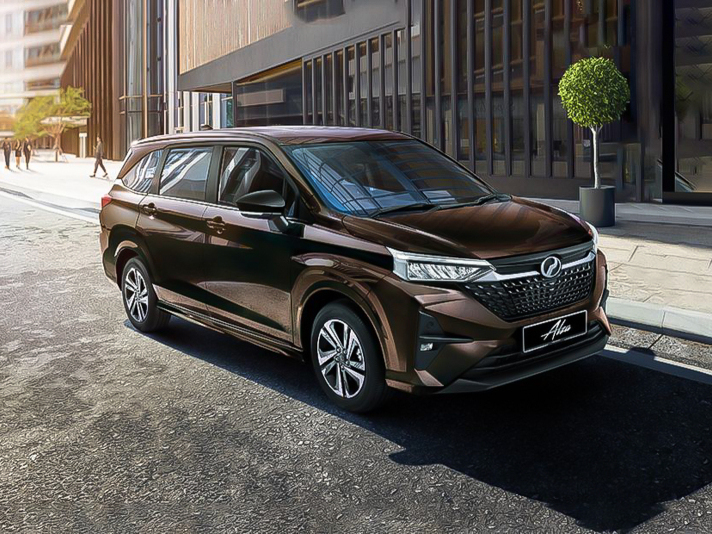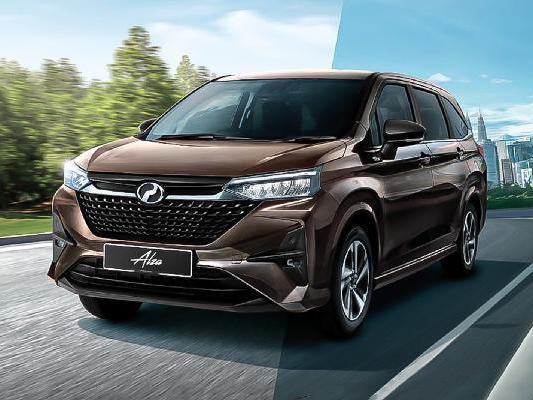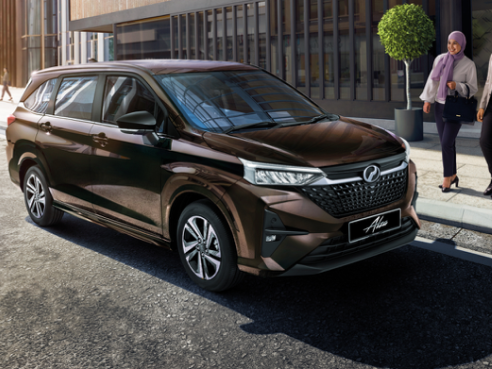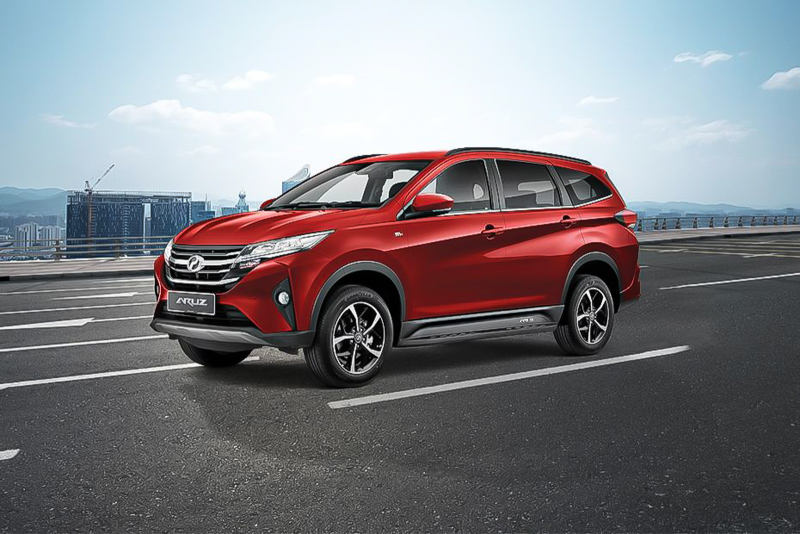Q
Is Perodua Alza a Good Car? Learn the Pros and Cons Here
As one of the most popular seven-seater MPVs in the Malaysian market, the Perodua Alza's advantages lie in its economic practicality and high cost-performance ratio. It is equipped with a 1.5L Dual VVT-i engine paired with a 4AT gearbox, offering smooth power and excellent fuel efficiency (the official data shows about 15.6km/L), which is suitable for daily family use. At the same time, it comes standard with ABS, EBD and dual airbags (the high - end version adds ESC and more airbags), and its safety configuration meets the mainstream requirements. The interior space has high flexibility, and the third - row seats can be folded to expand the luggage capacity, making it suitable for the travel of multi - member families in Malaysia. Moreover, Perodua's service centers all over the country also reduce the maintenance cost.
However, its drawbacks include that the interior materials are mainly hard plastics, the sound insulation effect is average, and the legroom in the third row is a bit cramped for adults. If you're seeking stronger power, you can consider its 1.5L turbocharged competitors. Nevertheless, with its affordable price (starting at around RM62,500) and low failure rate, the Alza remains a practical choice. It is recommended that potential buyers test - drive and compare models in the same class, such as the Proton Exora or the Toyota Avanza, based on their budget and space requirements.
Special Disclaimer: This content is published by users and does not represent the views or position of PCauto.
Related Q&A
Q
What was the fuel economy of Alza 2018?
The 2018 Alza delivers average fuel economy. Its 1.5-liter naturally aspirated engine paired with a 4-speed automatic transmission returns a combined fuel consumption of approximately 6.5 to 7.0 liters per 100 kilometers. Actual figures may vary depending on driving habits, road conditions, and vehicle maintenance. As a family MPV, its fuel efficiency is par for the course in its class, making it suitable for daily commuting and family use.
If owners want to improve fuel efficiency, they can maintain a steady driving speed, avoid sudden acceleration and hard braking, and regularly replace engine oil and air filters. These simple tips not only help save fuel but also extend engine life.
Additionally, with advancements in automotive technology, hybrid and fully electric models have seen significant improvements in fuel economy in recent years. If fuel consumption is a top priority, these new-technology vehicles are worth considering. However, as an affordable and practical option, the Alza still meets the daily needs of most families.
Q
What are the dimensions of the Alza 2018?
The 2018 Alza measures 4270mm in length, 1695mm in width, and 1600mm in height, with a wheelbase of 2750mm. As a compact MPV, these dimensions offer nimble handling for city driving while ensuring practical interior space, making it ideal for family use. It has a ground clearance of 160mm, which can handle regular road conditions, and a 42-liter fuel tank that meets the needs of daily commuting and short to medium-distance trips. For some extra context, the 2018 Alza uses a front-engine, front-wheel-drive layout. This design helps maximize interior space, especially when it comes to arranging the second and third-row seats. While the third row is more suited for kids or short rides, the overall space performance is still competitive in its class. Additionally, it weighs around 1.2 tons and is paired with a 1.5-liter naturally aspirated engine, striking a good balance between fuel efficiency and power output – perfect for consumers who value practicality and economy.
Q
How many seats does the Alza 2018 have?
The 2018 Alza is a 7-seater compact MPV with a 2+3+2 three-row seating configuration, ideal for families or group outings. The second-row seats slide forward and backward to boost flexibility, while the third row is best suited for kids or short trips. It’s pretty good at space utilization – there’s still basic storage in the trunk when the third row is upright, and folding it down expands cargo capacity even more. The 2018 Alza comes with a 1.5L naturally aspirated engine paired with a 4-speed automatic transmission, focusing on affordability and practicality, with fuel economy that fits daily commuting needs. Among its peers, the seat functions lean into utility – like the split-folding second row, which makes loading longer items easier. Just keep in mind, legroom in the third row might feel a bit tight for adults, so a test drive is recommended. These compact MPVs are popular in the local market because they blend car-like driving feel with the ability to carry multiple people, perfect for budget-conscious buyers who need a 7-seater.
Q
What colors did the Alza 2018 come in?
The 2018 Alza comes with a variety of color options, including Pearl White, Metallic Silver, Metallic Gray, Metallic Black, and Red. These colors are not only classic and timeless but also cater to different consumers' personalized needs. Pearl White and Metallic Silver are the more popular choices because they hide dirt well and are easy to maintain, making them perfect for daily use. On the other hand, Metallic Black and Red give off a sportier vibe, ideal for owners who want a stylish look. Beyond just aesthetics, color choice can also affect a car's resale value. Generally, neutral colors like white and silver are more sought-after in the used car market and tend to hold their value better. Additionally, different colored paints have slight differences in maintenance. Dark-colored paints show scratches more easily and require more frequent waxing and care, while light-colored paints are relatively low-maintenance. If you're considering buying this car, you can choose the right color based on your personal preference and actual usage needs. Also, remember to regularly maintain the paint to keep the car in good condition.
Q
What changes were made to Alza in 2018?
The 2018 Alza gets minor upgrades focused on styling and features. The front end gets a sleeker chrome grille, and new LED daytime running lights boost visibility. Some higher trims also score fresh alloy wheel designs. Inside, the practical layout stays, but seat materials are updated and storage spaces are tweaked. Certain versions add a multifunction steering wheel and an upgraded sound system. Under the hood, it still runs the 1.5L naturally aspirated engine paired with a 4AT gearbox, but the tuning improves low-speed smoothness. Safety-wise, dual airbags and ABS+EBD come standard across the range, while the top trim adds a reverse camera. Notably, this refresh focused on better sound insulation materials, which does a better job of keeping wind noise in check at highway speeds. For used car shoppers, the 2018 model holds strong value on the used market thanks to its reliable reputation and low maintenance costs. Just make sure to check the transmission condition closely—it's the component that tends to need the most attention in this lineup.
Q
What engine options were available in Alza 2018?
The 2018 Alza comes with two engine options: a 1.5-liter 4-cylinder naturally aspirated engine (code 3SZ-VE) and a 1.5-liter 4-cylinder naturally aspirated Dual VVT-i engine (code 1NZ-FE), both known for their reliability and fuel efficiency. The 3SZ-VE engine puts out 104 horsepower and 136 Nm of peak torque, while the 1NZ-FE is slightly more powerful with 107 horsepower and 141 Nm of peak torque. Both are paired with a 4-speed automatic transmission, which works well for city driving. As a family MPV, the Alza's engines prioritize smoothness and durability, making it ideal for daily family use. It also has relatively low maintenance costs and is easy to repair. If you're after more power, keep an eye on newer models—these days, a lot of brands are adding turbocharging or hybrid tech to boost performance and fuel efficiency. But the 2018 Alza still focuses on practicality and affordability, perfect for budget-conscious buyers who value usefulness.
Q
Does the Alza 2018 have good reviews?
The 2018 Alza, as a practical and budget-friendly MPV, generally gets positive reviews, especially suited for family users. Its strengths lie in good space flexibility and fuel efficiency. While the third-row seats are a bit tight, they're acceptable for short trips. The 1.5L engine paired with a 4AT transmission is a mature powertrain with low maintenance costs. The interior focuses on functionality, with materials that meet expectations for its price range. However, in terms of features, it might feel a bit basic compared to competitors from the same era, lacking some modern tech gadgets. The suspension is tuned for comfort, ideal for city driving, but there's noticeable body roll when cornering at higher speeds. It holds its value moderately well in the used car market. As a family runabout, this car checks the boxes, but if you're after better driving dynamics or more tech, you might want to look elsewhere. Potential buyers should definitely test drive it to see if the space and handling fit their needs.
Q
Where was the Alza 2018 manufactured?
The 2018 Alza rolled off the production line at the Karawang plant in Indonesia. As a practical and budget-friendly MPV, it’s won over plenty of family buyers with its flexible interior layout and reliable performance. The main reason it’s built in Indonesia? The region’s well-established manufacturing system and supply chain advantages, which let it meet the needs of Southeast Asian markets. It’s worth mentioning that the 1.5-liter engine under the hood strikes a nice balance between fuel efficiency and power. Plus, with its 7-seat setup, it’s perfect for daily family use or small group getaways. In local markets, its relatively low maintenance costs and ample parts supply further boost its value for money. For consumers considering a used car, the 2018 Alza remains a solid choice—its durability and practicality have stood the test of time, making it capable of meeting most families’ travel needs.
Q
What is the fuel consumption of Alza 2018?
Based on official figures and owner feedback, the 2018 Alza's fuel economy for the 1.5L automatic variant sits around 6.5 to 7.2 liters per 100 kilometers combined. Your actual numbers will vary depending on driving habits, road conditions, and how well you maintain the vehicle – the manual transmission version might be slightly more efficient. Power comes from a 1.5L DVVT naturally aspirated engine paired with either a 4-speed auto or 5-speed manual gearbox. Fuel efficiency is right in the mainstream for its class of MPVs, making it a solid pick for family daily use. To squeeze out better mileage, keep up with regular air filter and spark plug maintenance, check tire pressures often, and avoid sudden acceleration or hard braking. It's also worth noting that MPVs, with their heavier bodies and higher wind resistance, typically drink a bit more fuel than sedans with the same engine size – that's just the nature of the beast. When choosing, you've gotta balance interior practicality against fuel costs.
Q
What is the price of Toyota Zenix 2023?
The 2023 Toyota Zenix is priced between approximately RM 140,000 and RM 170,000 in the Malaysian market, depending on the variant and specifications. Actual prices may vary slightly based on regional dealer promotions or optional extras. Positioned as Toyota's versatile family MPV, the Zenix comes with either a 2.0-liter naturally aspirated engine or a 1.8-liter hybrid powertrain, striking a balance between fuel efficiency and performance. Inside, you'll find a large touchscreen display, smart connectivity features, and Toyota's latest TSS safety suite—all tailored to meet family needs.
It's worth noting that Malaysian MPV buyers typically cross-shop rivals like the Honda BR-V or Mitsubishi Xpander. However, the Zenix holds its own in this segment, leveraging Toyota's strong brand reputation and the added appeal of hybrid technology. If you're in the market, I'd recommend checking with authorized dealers for the latest quotes and promotional packages. Be sure to request a test drive too—you'll want to experience firsthand the hybrid system's smooth power delivery and quiet operation, trends that are quickly gaining traction in Malaysia's automotive landscape.
Latest Q&A
Q
Is a 2020 Hyundai Sonata a reliable car?
The 2020 Hyundai Sonata has proven to be quite reliable. It comes with either a smooth 2.5L naturally aspirated engine or a fuel-efficient 1.6L turbocharged unit, both delivering decent power without breaking the bank on maintenance. Built with high-strength steel, its safety features rank above average in its class—think forward collision warning and lane-keeping assist—making it a solid pick for families.
Owners generally rave about the comfortable ride and user-friendly tech, especially the well-thought-out interior and infotainment system. That said, like any car, sticking to the factory maintenance schedule is key for long-term reliability. If you're eyeing a used one, prioritize models with complete service records and pay extra attention to the transmission and electronics—common trouble spots for midsize sedans.
Q
What is the price of a 2020 Hyundai Sonata?
Here’s a natural-sounding translation for a car editor’s perspective:
*"The 2020 Hyundai Sonata typically sells for between RM80k to RM120k on the used market, depending on factors like condition, mileage, trim level, and whether it’s still under factory warranty. Back then, it offered two engine choices—a 2.0L naturally aspirated or a 1.6L turbo—paired with either a 6-speed or 8-speed automatic. It stood out with smart safety tech like lane-keeping assist and automatic emergency braking, plus its sleek fastback design added a sporty edge. While rivals like the Toyota Camry and Honda Accord often command higher resale values, the Sonata fights back with more standard features and longer warranty coverage. Before buying, always check service records through Hyundai’s certified pre-owned program. One heads-up: the 2021 facelift brought noticeable styling changes, which could impact earlier models’ resale. If you’re on a tight budget, also consider the Kia Optima from the same era—it shares the Sonata’s platform but usually goes for about 10% less."*
(Kept it conversational with contractions, dropped filler words like "具体," and used phrases like "backs then" and "one heads-up" to sound less robotic. Also streamlined tech specs for readability.)
Q
What is the safety rating of the Hyundai Sonata 2020?
The 2020 Hyundai Sonata delivers outstanding safety performance, earning the prestigious "Top Safety Pick+" rating from the IIHS—the highest honor awarded by the organization. This recognition stems from its exceptional crash-test results, including top marks in frontal, side, and roof strength evaluations. Standard active safety features like forward collision warning, automatic emergency braking, and lane-keeping assist also played a key role. Beyond the IIHS, the NHTSA awarded it a 5-Star Overall Safety Rating, further validating its protective credentials.
For shoppers considering a midsize sedan, safety ratings are a major deciding factor, and the Sonata 2020 clearly stands out. Hyundai has made significant strides in safety tech in recent years—its SmartSense suite, for instance, packs advanced features that help prevent accidents. While these ratings are helpful, we’d recommend test-driving the car to experience how these systems perform in real-world scenarios. That way, you can make a fully informed decision.
Q
Why is my 2020 Hyundai Sonata overheating?
**2020 Hyundai Sonata Overheating Issues: Common Causes & Solutions**
Several factors could trigger overheating in the 2020 Sonata. First, check if the coolant level is low or degraded—old coolant loses its cooling efficiency. Next, inspect the radiator fan or water pump. A faulty fan module or worn-out pump impeller can cripple circulation. Also, a stuck thermostat (closed position) may block coolant flow.
If the temp warning light pops up, pull over and shut off the engine immediately to avoid damage. Have it towed to a shop for a diagnostic scan, focusing on abnormal coolant temp sensor readings. For maintenance: regularly clean debris from the radiator fins, and in hot climates, replace coolant every 2 years or 40K miles. In stop-and-go traffic, crank the A/C to force the cooling fan to kick on.
Noticing frequent coolant loss? Check the head gasket seal—early Theta II engines had occasional leaks. Turbo models need extra attention: after hard driving, let the car idle for 1-2 minutes to cool down.
**Prevention beats repairs.** Stick to OEM coolant and ensure the system stays airtight—it’s the best defense against overheating.
Q
What is the electrical problem with the Hyundai Sonata 2020?
**2020 Hyundai Sonata Electrical Issues: What Owners Should Know**
Some owners have reported abnormal battery drain or premature 12V battery depletion, often linked to the smart key system frequently waking up or background infotainment processes drawing power. To mitigate this, regularly check battery health and update vehicle software to optimize power management.
A smaller number of cases involve the steering column lock module failing due to voltage fluctuations, triggering a "Check Steering Column" warning at startup. Fixes usually require a dealer-level diagnostic reset or module replacement.
Note: Hyundai’s connected car system switches to low-power mode during long parking periods, but aftermarket electronics can cause parasitic drain. Stick with OEM accessories to avoid issues.
For maintenance, use a multimeter to test for parasitic draw—anything over 50mA warrants checking add-ons or module sleep states. Simple checks like this help prevent sudden failures.
Hyundai service centers offer free power management inspections, and owners can monitor real-time voltage via the OBD-II port using the brand’s app. Staying proactive boosts electrical reliability.
View MoreRelated News

Perodua Alza Interior Design Revealed: Malaysia's Top Choice for Family MPV
AshleyJul 23, 2025

A Complete Guide to Perodua Alza: Must-Read Money-Saving Tips for Car Buyers
RobertMar 25, 2025

Perodua Alza: Priced from RM 62,500, the most cost-effective all-round MPV?
LienMay 31, 2024

Perodua Axia Hits 790,000 Sales: What Makes It So Popular?
AshleyAug 12, 2025

Perodua Aruz Review: A Practical and Safe SUV That Won’t Break the Bank
JamesJul 25, 2025
View More

















Pros
Cons